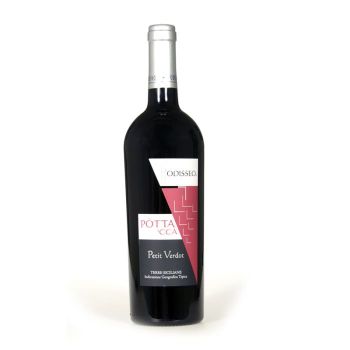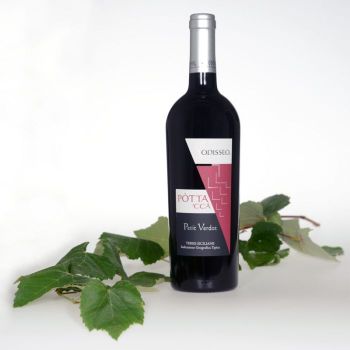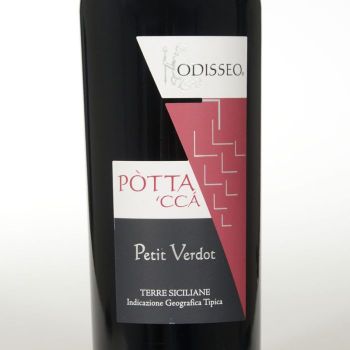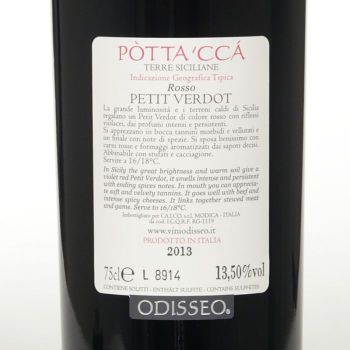Pòtta’ccà – Petit Verdot I.G.T. Sicilian Lands, Odisseo Sicilian Wines
“Pòtta ‘ccà” or “Bring it here” is a Modican expression that invites people to pass around a glass of wine so that they can experience the taste and emotions that it contains. The Petit Verdot grape brings colour and perfumes to the glass with voluptuous and round tannins, floral aromas and fruity notes that make the wine both romantic and graceful. Spicy notes and red and purple hues evoke curiosity. So “Pòtta ’ccà” is a must!




Details
Odysseus Petit Verdot I.G.T. Terre Siciliane
The Petit Verdot I.G.T. by Odisseo’s cellars is a red wine by the intriguing garnet color with violet hues. Its taste is round, tannic, with hints of spice. The nose is frank, balanced and fruity with hints of rose and blackberry. Its alcohol content is 13.5% and has an aging potential of 10 years. The wine is made in red with submerged cap to get sweeter tannins. The punching also give this wine its color. Subsequently are carried délestage thanks to which is fixed the color of the wine and the tannins are softened. It is served at a temperature of 16/18 ° and is accompanied by strong flavors such as red meat, stews and spicy cheeses.
History
The vine is a native of Petit Verdot Médoc, an area located in northern France, the area in which the product is Bordeaux. Towards the end of the last century the French production is significantly decreased, while the other hand is widespread in Italy, Greece, California, Spain, China, Argentina, Venezuela and Canada.
The vine
The Petit Verdot is a late ripening grape variety, his harvest is between late September and mid-October. It ‘a crop that prefers sunny areas and ventilated. The Petit Verdot produces some round berries and blue color very dark, the leaves are medium to small and medium sized. Grape Petit Verdot produces wines with fruity and spicy and tannic taste. The wine made from Petit Verdot has a characteristic ruby red color.
Uses
In addition to producing the wines, Petit Verdot contribute to the production of other wines in which it is used to give color, tannins and aromas. The Petit Verdot contributes, along with Merlot, Cabernet Franc and Cabernet Sauvignon, the production of Bordeaux. It, although to a lesser extent to other varieties, is used to give the wine its taste tannic Bordeaux, its fruity and spicy and its ruby red color.
Cultivation
The Petit Verdot by Odisseo’s cellars is grown in South Eastern Sicily. This area gives the varietal aromas of fruit and spices. The cultivation method is said to espalier or cordon, allowing the Petit Verdot to complete his late maturing enjoying a right exposure to the sun for the foliage and while holding the grapes well covered. The method called “controspalliera” or “cordon”, consists of a mixed structure composed of wooden supports alternating with metal poles crossed by 5 stainless steel wires on which the vine plant develops in a vertical manner. The grapes are selected and hand-picked.
More Information
| Classification | Petit Verdot I.G.T. Sicilian ground |
|---|---|
| Wine Type | Red Wine |
| Grape Variety | 100% Petit Verdot |
| Alcohol Content | 13,5% Vol. |
| Color | Garnet with purple reflections |
| Ageing potential | 10 Years |
| Food Pairing | Roasts, Carni rosse, Cheeses, Pastas, Game |
| Serving Temperature | 16° / 18° C |
| Taste | Round, tannic with hints of spice |
| Scent | Frank, harmonious and fruity with hints of roses and blackberries |
| Bottle | 750 ml |
| Place of production | South-Eastern Sicily |
| Altitude | 250 meters above sea level |
| Trailing System | Espalier, cordon |
| Grapes Yield | 4500/5000 vines per hectare |
| Vinification | Red wine vinification, which is conducted with submerged cap for the extraction of tannins sweeter and with pressing to obtain a good extraction of color. All this happens at a controlled temperature of 26/28 ° C. During the early stages of maceration are made of “délestage”, a technique that makes the tannins softer and more stable color. |
| Yield per hectare | 90/100 quintals per hectare |
| Harvest time | Third week of September |